Strategic Information Systems: Management Accounting Analysis
VerifiedAdded on 2021/01/03
|15
|4454
|241
Report
AI Summary
This report delves into the realm of strategic information systems, focusing on management accounting techniques and their applications. It begins with an introduction to management accounting, its essential requirements, and the differences between financial and management accounting. The report then explores various management accounting reporting methods, including cost reports, budgetary reports, and performance reports. A key section of the report focuses on cost calculation and income statement preparation, comparing and contrasting absorption costing and marginal costing methods. Through detailed calculations and interpretations, the report demonstrates how these costing techniques impact profit and loss statements. Furthermore, the report analyzes the advantages and disadvantages of different planning tools related to budgetary control and examines the effectiveness of businesses in solving financial problems through budgetary control. The report concludes with a summary of the key findings and a list of references.
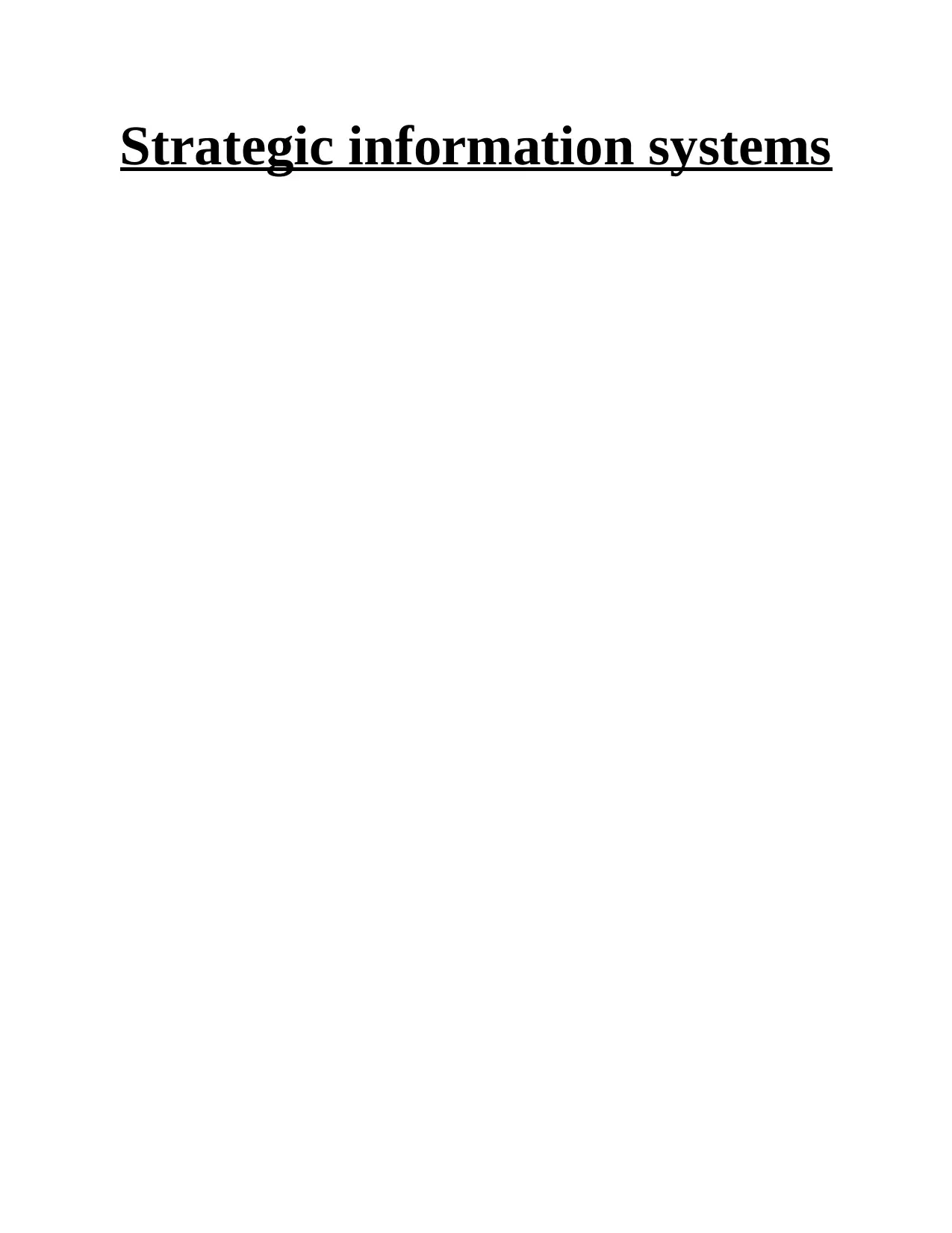
Strategic information systems
Paraphrase This Document
Need a fresh take? Get an instant paraphrase of this document with our AI Paraphraser

Table of Contents
INTRODUCTION...........................................................................................................................1
Task 1...............................................................................................................................................1
P1 management accounting and its essential requirements of different types of management
accounting system.......................................................................................................................1
P2 Different methods of management accounting reporting......................................................4
TASK 2............................................................................................................................................5
P3 calculation of costs and preparation of income statements....................................................5
P4 advantages and disadvantages of various planning tools of budgetary control.....................8
Effectiveness of business in solving financial problems through budgetary controlling..........10
CONCLUSION..............................................................................................................................12
REFERENCES..............................................................................................................................13
INTRODUCTION...........................................................................................................................1
Task 1...............................................................................................................................................1
P1 management accounting and its essential requirements of different types of management
accounting system.......................................................................................................................1
P2 Different methods of management accounting reporting......................................................4
TASK 2............................................................................................................................................5
P3 calculation of costs and preparation of income statements....................................................5
P4 advantages and disadvantages of various planning tools of budgetary control.....................8
Effectiveness of business in solving financial problems through budgetary controlling..........10
CONCLUSION..............................................................................................................................12
REFERENCES..............................................................................................................................13
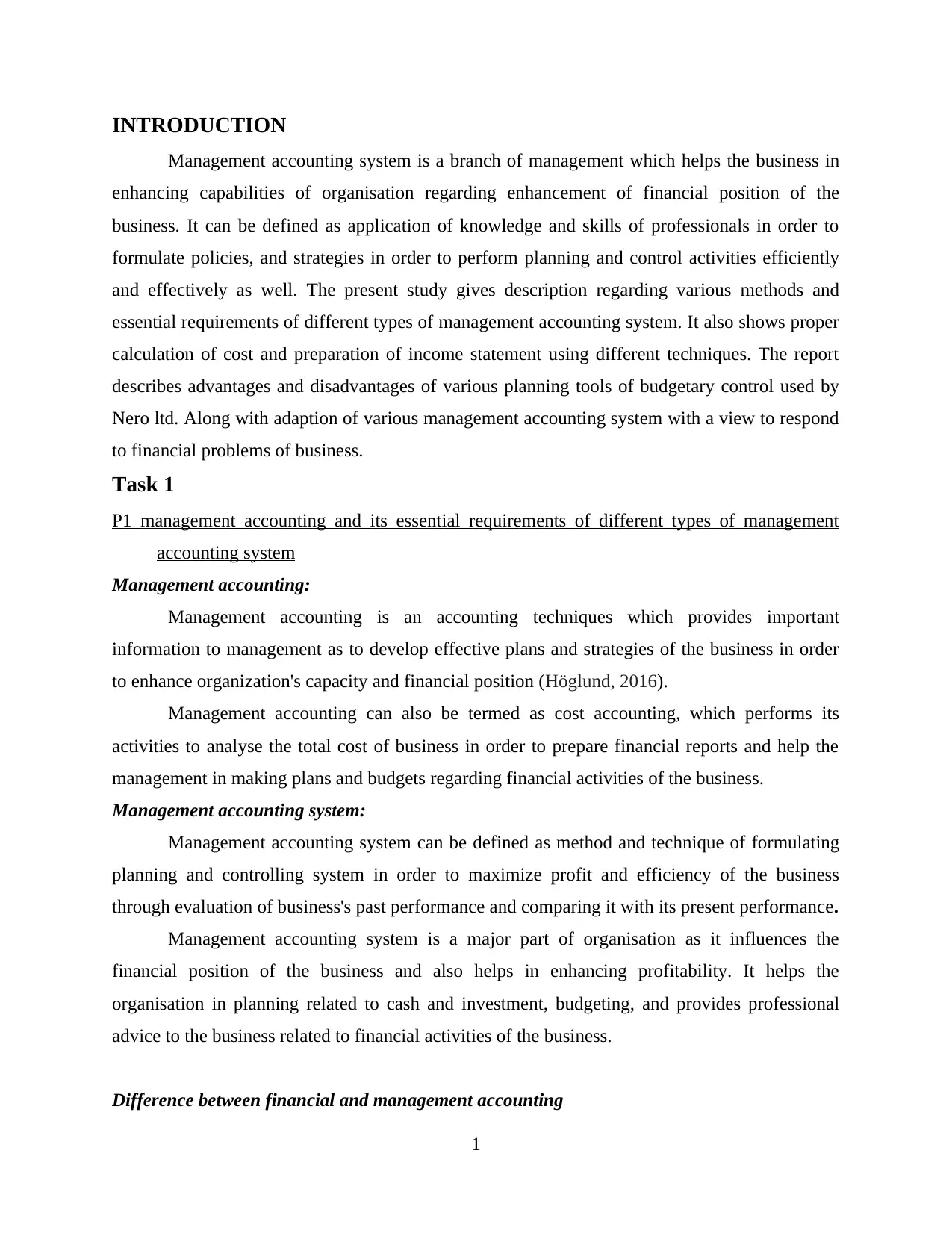
INTRODUCTION
Management accounting system is a branch of management which helps the business in
enhancing capabilities of organisation regarding enhancement of financial position of the
business. It can be defined as application of knowledge and skills of professionals in order to
formulate policies, and strategies in order to perform planning and control activities efficiently
and effectively as well. The present study gives description regarding various methods and
essential requirements of different types of management accounting system. It also shows proper
calculation of cost and preparation of income statement using different techniques. The report
describes advantages and disadvantages of various planning tools of budgetary control used by
Nero ltd. Along with adaption of various management accounting system with a view to respond
to financial problems of business.
Task 1
P1 management accounting and its essential requirements of different types of management
accounting system
Management accounting:
Management accounting is an accounting techniques which provides important
information to management as to develop effective plans and strategies of the business in order
to enhance organization's capacity and financial position (Höglund, 2016).
Management accounting can also be termed as cost accounting, which performs its
activities to analyse the total cost of business in order to prepare financial reports and help the
management in making plans and budgets regarding financial activities of the business.
Management accounting system:
Management accounting system can be defined as method and technique of formulating
planning and controlling system in order to maximize profit and efficiency of the business
through evaluation of business's past performance and comparing it with its present performance.
Management accounting system is a major part of organisation as it influences the
financial position of the business and also helps in enhancing profitability. It helps the
organisation in planning related to cash and investment, budgeting, and provides professional
advice to the business related to financial activities of the business.
Difference between financial and management accounting
1
Management accounting system is a branch of management which helps the business in
enhancing capabilities of organisation regarding enhancement of financial position of the
business. It can be defined as application of knowledge and skills of professionals in order to
formulate policies, and strategies in order to perform planning and control activities efficiently
and effectively as well. The present study gives description regarding various methods and
essential requirements of different types of management accounting system. It also shows proper
calculation of cost and preparation of income statement using different techniques. The report
describes advantages and disadvantages of various planning tools of budgetary control used by
Nero ltd. Along with adaption of various management accounting system with a view to respond
to financial problems of business.
Task 1
P1 management accounting and its essential requirements of different types of management
accounting system
Management accounting:
Management accounting is an accounting techniques which provides important
information to management as to develop effective plans and strategies of the business in order
to enhance organization's capacity and financial position (Höglund, 2016).
Management accounting can also be termed as cost accounting, which performs its
activities to analyse the total cost of business in order to prepare financial reports and help the
management in making plans and budgets regarding financial activities of the business.
Management accounting system:
Management accounting system can be defined as method and technique of formulating
planning and controlling system in order to maximize profit and efficiency of the business
through evaluation of business's past performance and comparing it with its present performance.
Management accounting system is a major part of organisation as it influences the
financial position of the business and also helps in enhancing profitability. It helps the
organisation in planning related to cash and investment, budgeting, and provides professional
advice to the business related to financial activities of the business.
Difference between financial and management accounting
1
⊘ This is a preview!⊘
Do you want full access?
Subscribe today to unlock all pages.

Trusted by 1+ million students worldwide
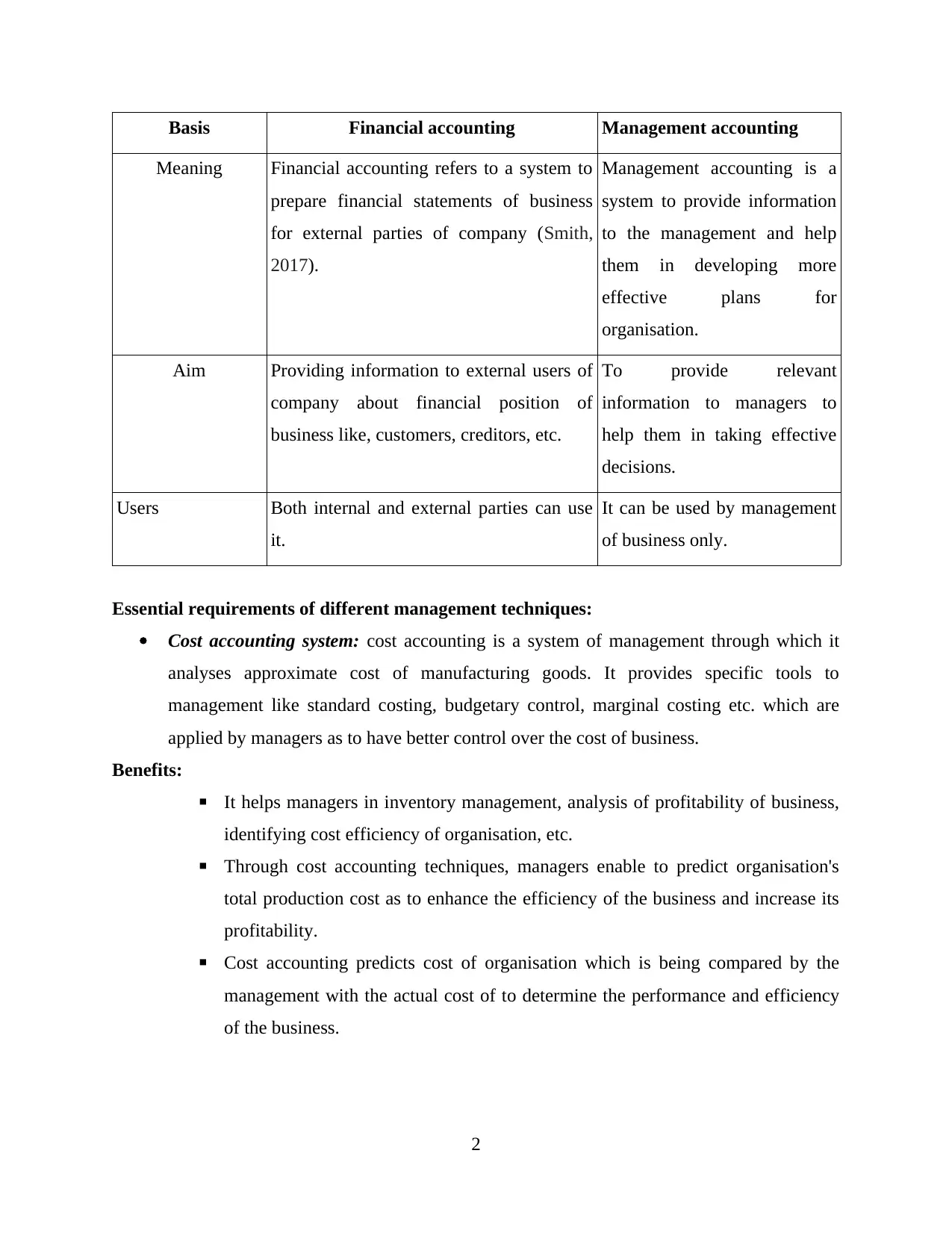
Basis Financial accounting Management accounting
Meaning Financial accounting refers to a system to
prepare financial statements of business
for external parties of company (Smith,
2017).
Management accounting is a
system to provide information
to the management and help
them in developing more
effective plans for
organisation.
Aim Providing information to external users of
company about financial position of
business like, customers, creditors, etc.
To provide relevant
information to managers to
help them in taking effective
decisions.
Users Both internal and external parties can use
it.
It can be used by management
of business only.
Essential requirements of different management techniques:
Cost accounting system: cost accounting is a system of management through which it
analyses approximate cost of manufacturing goods. It provides specific tools to
management like standard costing, budgetary control, marginal costing etc. which are
applied by managers as to have better control over the cost of business.
Benefits:
▪ It helps managers in inventory management, analysis of profitability of business,
identifying cost efficiency of organisation, etc.
▪ Through cost accounting techniques, managers enable to predict organisation's
total production cost as to enhance the efficiency of the business and increase its
profitability.
▪ Cost accounting predicts cost of organisation which is being compared by the
management with the actual cost of to determine the performance and efficiency
of the business.
2
Meaning Financial accounting refers to a system to
prepare financial statements of business
for external parties of company (Smith,
2017).
Management accounting is a
system to provide information
to the management and help
them in developing more
effective plans for
organisation.
Aim Providing information to external users of
company about financial position of
business like, customers, creditors, etc.
To provide relevant
information to managers to
help them in taking effective
decisions.
Users Both internal and external parties can use
it.
It can be used by management
of business only.
Essential requirements of different management techniques:
Cost accounting system: cost accounting is a system of management through which it
analyses approximate cost of manufacturing goods. It provides specific tools to
management like standard costing, budgetary control, marginal costing etc. which are
applied by managers as to have better control over the cost of business.
Benefits:
▪ It helps managers in inventory management, analysis of profitability of business,
identifying cost efficiency of organisation, etc.
▪ Through cost accounting techniques, managers enable to predict organisation's
total production cost as to enhance the efficiency of the business and increase its
profitability.
▪ Cost accounting predicts cost of organisation which is being compared by the
management with the actual cost of to determine the performance and efficiency
of the business.
2
Paraphrase This Document
Need a fresh take? Get an instant paraphrase of this document with our AI Paraphraser
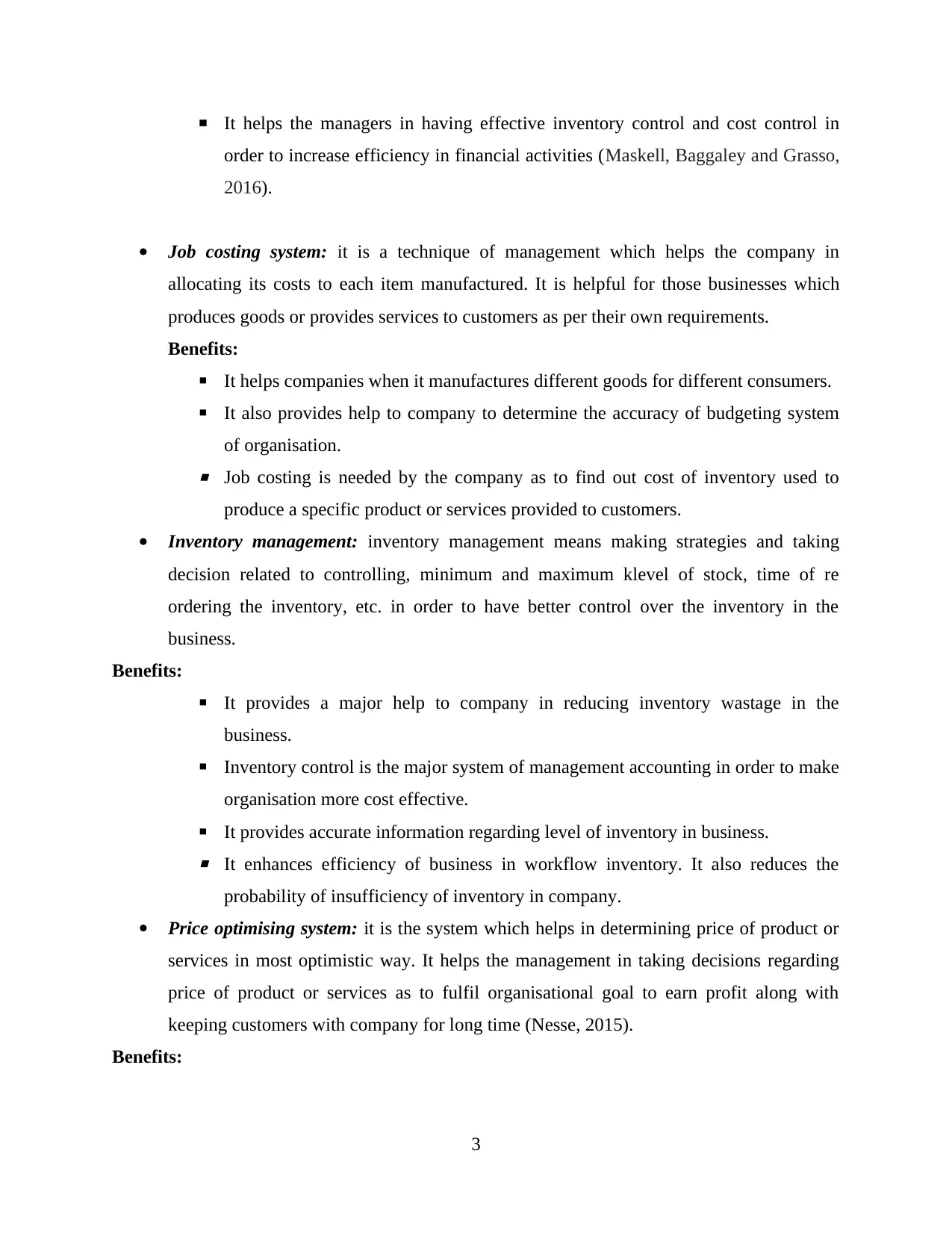
▪ It helps the managers in having effective inventory control and cost control in
order to increase efficiency in financial activities (Maskell, Baggaley and Grasso,
2016).
Job costing system: it is a technique of management which helps the company in
allocating its costs to each item manufactured. It is helpful for those businesses which
produces goods or provides services to customers as per their own requirements.
Benefits:
▪ It helps companies when it manufactures different goods for different consumers.
▪ It also provides help to company to determine the accuracy of budgeting system
of organisation.
▪ Job costing is needed by the company as to find out cost of inventory used to
produce a specific product or services provided to customers.
Inventory management: inventory management means making strategies and taking
decision related to controlling, minimum and maximum klevel of stock, time of re
ordering the inventory, etc. in order to have better control over the inventory in the
business.
Benefits:
▪ It provides a major help to company in reducing inventory wastage in the
business.
▪ Inventory control is the major system of management accounting in order to make
organisation more cost effective.
▪ It provides accurate information regarding level of inventory in business.
▪ It enhances efficiency of business in workflow inventory. It also reduces the
probability of insufficiency of inventory in company.
Price optimising system: it is the system which helps in determining price of product or
services in most optimistic way. It helps the management in taking decisions regarding
price of product or services as to fulfil organisational goal to earn profit along with
keeping customers with company for long time (Nesse, 2015).
Benefits:
3
order to increase efficiency in financial activities (Maskell, Baggaley and Grasso,
2016).
Job costing system: it is a technique of management which helps the company in
allocating its costs to each item manufactured. It is helpful for those businesses which
produces goods or provides services to customers as per their own requirements.
Benefits:
▪ It helps companies when it manufactures different goods for different consumers.
▪ It also provides help to company to determine the accuracy of budgeting system
of organisation.
▪ Job costing is needed by the company as to find out cost of inventory used to
produce a specific product or services provided to customers.
Inventory management: inventory management means making strategies and taking
decision related to controlling, minimum and maximum klevel of stock, time of re
ordering the inventory, etc. in order to have better control over the inventory in the
business.
Benefits:
▪ It provides a major help to company in reducing inventory wastage in the
business.
▪ Inventory control is the major system of management accounting in order to make
organisation more cost effective.
▪ It provides accurate information regarding level of inventory in business.
▪ It enhances efficiency of business in workflow inventory. It also reduces the
probability of insufficiency of inventory in company.
Price optimising system: it is the system which helps in determining price of product or
services in most optimistic way. It helps the management in taking decisions regarding
price of product or services as to fulfil organisational goal to earn profit along with
keeping customers with company for long time (Nesse, 2015).
Benefits:
3
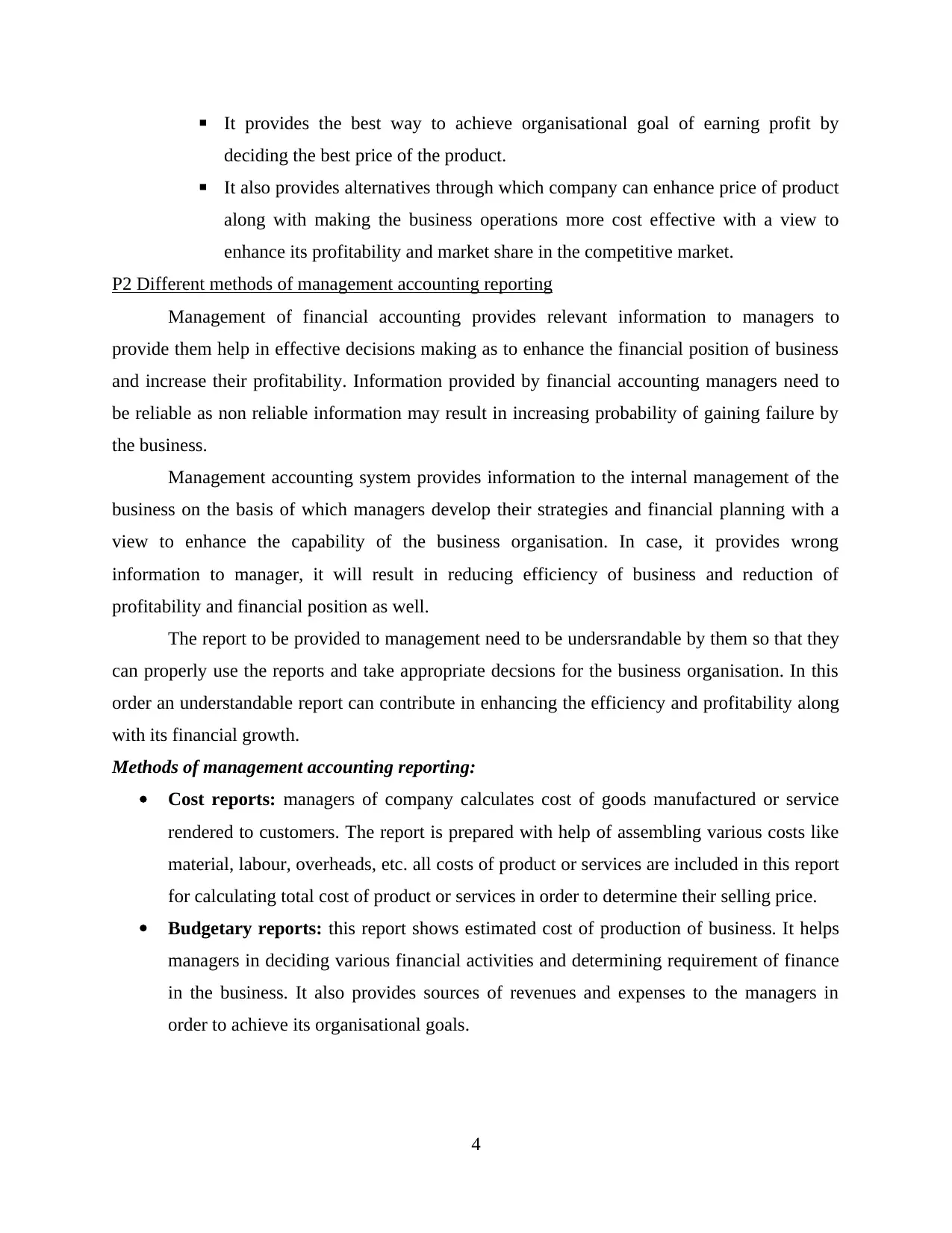
▪ It provides the best way to achieve organisational goal of earning profit by
deciding the best price of the product.
▪ It also provides alternatives through which company can enhance price of product
along with making the business operations more cost effective with a view to
enhance its profitability and market share in the competitive market.
P2 Different methods of management accounting reporting
Management of financial accounting provides relevant information to managers to
provide them help in effective decisions making as to enhance the financial position of business
and increase their profitability. Information provided by financial accounting managers need to
be reliable as non reliable information may result in increasing probability of gaining failure by
the business.
Management accounting system provides information to the internal management of the
business on the basis of which managers develop their strategies and financial planning with a
view to enhance the capability of the business organisation. In case, it provides wrong
information to manager, it will result in reducing efficiency of business and reduction of
profitability and financial position as well.
The report to be provided to management need to be undersrandable by them so that they
can properly use the reports and take appropriate decsions for the business organisation. In this
order an understandable report can contribute in enhancing the efficiency and profitability along
with its financial growth.
Methods of management accounting reporting:
Cost reports: managers of company calculates cost of goods manufactured or service
rendered to customers. The report is prepared with help of assembling various costs like
material, labour, overheads, etc. all costs of product or services are included in this report
for calculating total cost of product or services in order to determine their selling price.
Budgetary reports: this report shows estimated cost of production of business. It helps
managers in deciding various financial activities and determining requirement of finance
in the business. It also provides sources of revenues and expenses to the managers in
order to achieve its organisational goals.
4
deciding the best price of the product.
▪ It also provides alternatives through which company can enhance price of product
along with making the business operations more cost effective with a view to
enhance its profitability and market share in the competitive market.
P2 Different methods of management accounting reporting
Management of financial accounting provides relevant information to managers to
provide them help in effective decisions making as to enhance the financial position of business
and increase their profitability. Information provided by financial accounting managers need to
be reliable as non reliable information may result in increasing probability of gaining failure by
the business.
Management accounting system provides information to the internal management of the
business on the basis of which managers develop their strategies and financial planning with a
view to enhance the capability of the business organisation. In case, it provides wrong
information to manager, it will result in reducing efficiency of business and reduction of
profitability and financial position as well.
The report to be provided to management need to be undersrandable by them so that they
can properly use the reports and take appropriate decsions for the business organisation. In this
order an understandable report can contribute in enhancing the efficiency and profitability along
with its financial growth.
Methods of management accounting reporting:
Cost reports: managers of company calculates cost of goods manufactured or service
rendered to customers. The report is prepared with help of assembling various costs like
material, labour, overheads, etc. all costs of product or services are included in this report
for calculating total cost of product or services in order to determine their selling price.
Budgetary reports: this report shows estimated cost of production of business. It helps
managers in deciding various financial activities and determining requirement of finance
in the business. It also provides sources of revenues and expenses to the managers in
order to achieve its organisational goals.
4
⊘ This is a preview!⊘
Do you want full access?
Subscribe today to unlock all pages.

Trusted by 1+ million students worldwide
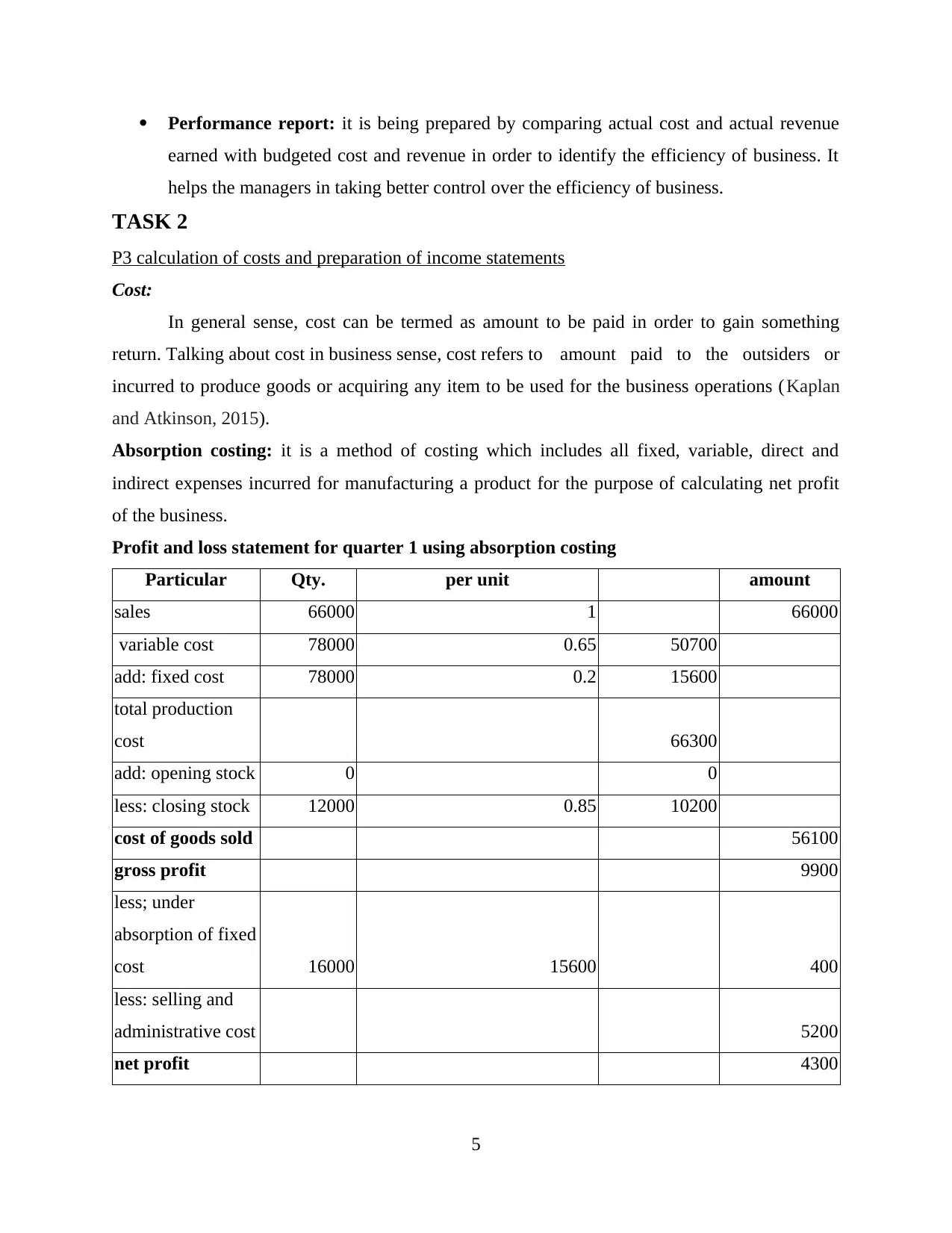
Performance report: it is being prepared by comparing actual cost and actual revenue
earned with budgeted cost and revenue in order to identify the efficiency of business. It
helps the managers in taking better control over the efficiency of business.
TASK 2
P3 calculation of costs and preparation of income statements
Cost:
In general sense, cost can be termed as amount to be paid in order to gain something
return. Talking about cost in business sense, cost refers to amount paid to the outsiders or
incurred to produce goods or acquiring any item to be used for the business operations (Kaplan
and Atkinson, 2015).
Absorption costing: it is a method of costing which includes all fixed, variable, direct and
indirect expenses incurred for manufacturing a product for the purpose of calculating net profit
of the business.
Profit and loss statement for quarter 1 using absorption costing
Particular Qty. per unit amount
sales 66000 1 66000
variable cost 78000 0.65 50700
add: fixed cost 78000 0.2 15600
total production
cost 66300
add: opening stock 0 0
less: closing stock 12000 0.85 10200
cost of goods sold 56100
gross profit 9900
less; under
absorption of fixed
cost 16000 15600 400
less: selling and
administrative cost 5200
net profit 4300
5
earned with budgeted cost and revenue in order to identify the efficiency of business. It
helps the managers in taking better control over the efficiency of business.
TASK 2
P3 calculation of costs and preparation of income statements
Cost:
In general sense, cost can be termed as amount to be paid in order to gain something
return. Talking about cost in business sense, cost refers to amount paid to the outsiders or
incurred to produce goods or acquiring any item to be used for the business operations (Kaplan
and Atkinson, 2015).
Absorption costing: it is a method of costing which includes all fixed, variable, direct and
indirect expenses incurred for manufacturing a product for the purpose of calculating net profit
of the business.
Profit and loss statement for quarter 1 using absorption costing
Particular Qty. per unit amount
sales 66000 1 66000
variable cost 78000 0.65 50700
add: fixed cost 78000 0.2 15600
total production
cost 66300
add: opening stock 0 0
less: closing stock 12000 0.85 10200
cost of goods sold 56100
gross profit 9900
less; under
absorption of fixed
cost 16000 15600 400
less: selling and
administrative cost 5200
net profit 4300
5
Paraphrase This Document
Need a fresh take? Get an instant paraphrase of this document with our AI Paraphraser

Profit and loss statement for quarter 2 using absorption costing
Particular Qty. per unit amount
sales 74000 1 74000
variable cost 66000 0.65 42900
add: fixed cost 66000 0.2 13200
total production
cost 56100
add: opening stock 12000 0.85 10200
less: closing stock 4000 0.85 3400
cost of goods sold 62900
gross profit 11100
less; under
absorption of fixed
cost 16000 13200 2800
less: selling and
administrative cost 5200
net profit 3100
Marginal costing: it refers to a cost of product which includes all the variable cost incurred on
production of goods along with writing off fixed cost against it.
Profit and loss statement for quarter 1 using marginal costing
Particular Qty. per unit amount
sales 66000 1 66000
production cost
variable cost 78000 0.65 50700
add: opening stock 0 0
less: closing stock 12000 0.65 7800
cost of goods sold 42900
contribution margin 23100
less: selling and administrative 5200
6
Particular Qty. per unit amount
sales 74000 1 74000
variable cost 66000 0.65 42900
add: fixed cost 66000 0.2 13200
total production
cost 56100
add: opening stock 12000 0.85 10200
less: closing stock 4000 0.85 3400
cost of goods sold 62900
gross profit 11100
less; under
absorption of fixed
cost 16000 13200 2800
less: selling and
administrative cost 5200
net profit 3100
Marginal costing: it refers to a cost of product which includes all the variable cost incurred on
production of goods along with writing off fixed cost against it.
Profit and loss statement for quarter 1 using marginal costing
Particular Qty. per unit amount
sales 66000 1 66000
production cost
variable cost 78000 0.65 50700
add: opening stock 0 0
less: closing stock 12000 0.65 7800
cost of goods sold 42900
contribution margin 23100
less: selling and administrative 5200
6

overheads
less: fixed manufacturing expenses 16000
net profit 1900
Profit and loss statement for quarter 2 using marginal costing
Particular Qty. per unit amount
sales 74000 1 74000
production cost
variable cost 66000 0.65 42900
add: opening stock 12000 0.65 7800
less: closing stock 4000 0.65 2600
cost of goods sold 48100
contribution margin 25900
less: selling and
administrative
overheads 5200
less: fixed
manufacturing
expenses 16000
net profit 4700
Interpretation:
Both techniques are useful for the business in order to calculate cost of production. From
the above calculation it can be interpret that net profit calculated from absorption costing comes
less than marginal costing. It happens because while calculating net profit from marginal costing,
under or over absorption costs are not included.
Cost volume profit:
Cost volume profit is a method used in cost accounting which determines the variation of
cost at different level of business operations. Its helps the business in determining break even
point in order to determine different sales volume and decide price of product or services
7
less: fixed manufacturing expenses 16000
net profit 1900
Profit and loss statement for quarter 2 using marginal costing
Particular Qty. per unit amount
sales 74000 1 74000
production cost
variable cost 66000 0.65 42900
add: opening stock 12000 0.65 7800
less: closing stock 4000 0.65 2600
cost of goods sold 48100
contribution margin 25900
less: selling and
administrative
overheads 5200
less: fixed
manufacturing
expenses 16000
net profit 4700
Interpretation:
Both techniques are useful for the business in order to calculate cost of production. From
the above calculation it can be interpret that net profit calculated from absorption costing comes
less than marginal costing. It happens because while calculating net profit from marginal costing,
under or over absorption costs are not included.
Cost volume profit:
Cost volume profit is a method used in cost accounting which determines the variation of
cost at different level of business operations. Its helps the business in determining break even
point in order to determine different sales volume and decide price of product or services
7
⊘ This is a preview!⊘
Do you want full access?
Subscribe today to unlock all pages.

Trusted by 1+ million students worldwide
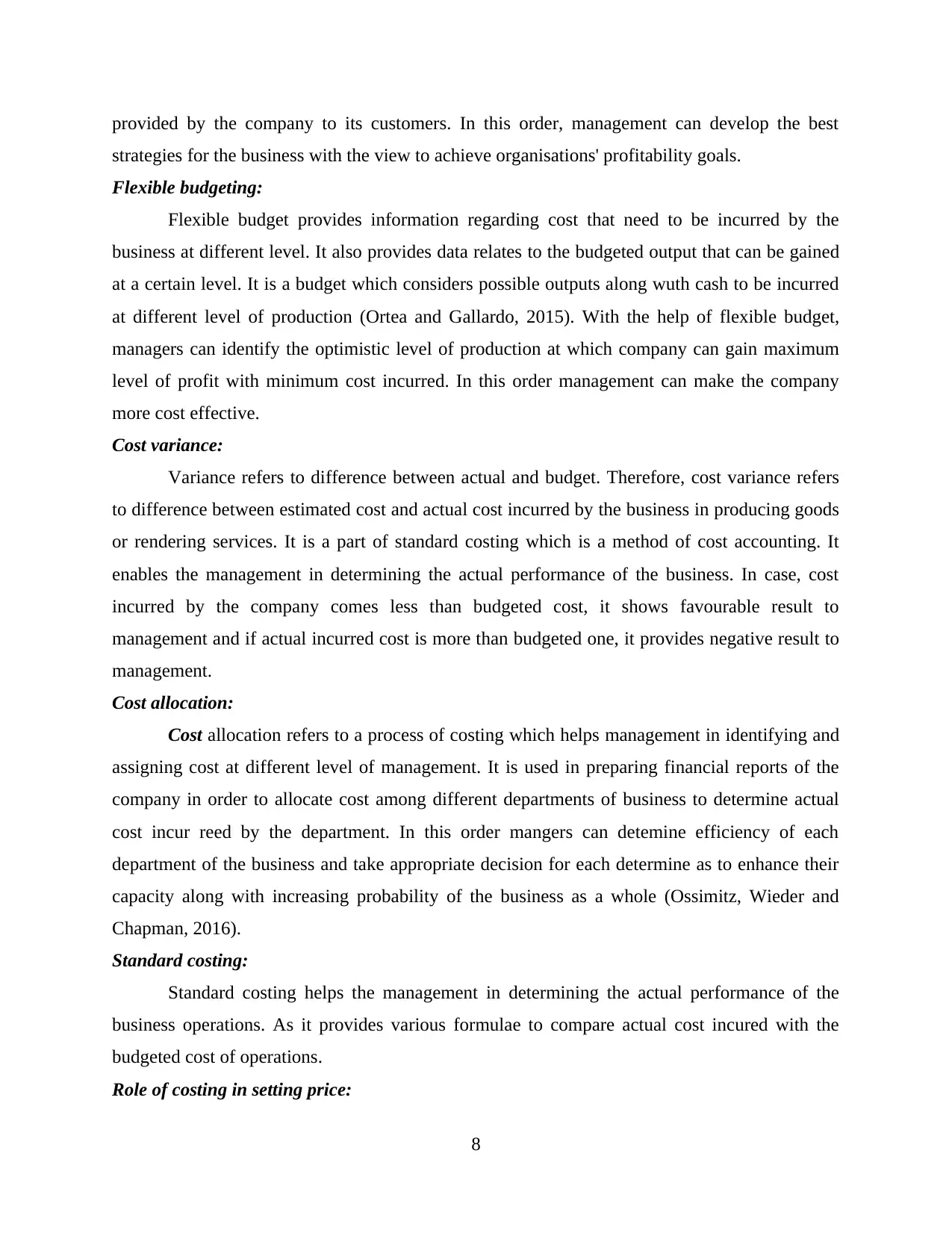
provided by the company to its customers. In this order, management can develop the best
strategies for the business with the view to achieve organisations' profitability goals.
Flexible budgeting:
Flexible budget provides information regarding cost that need to be incurred by the
business at different level. It also provides data relates to the budgeted output that can be gained
at a certain level. It is a budget which considers possible outputs along wuth cash to be incurred
at different level of production (Ortea and Gallardo, 2015). With the help of flexible budget,
managers can identify the optimistic level of production at which company can gain maximum
level of profit with minimum cost incurred. In this order management can make the company
more cost effective.
Cost variance:
Variance refers to difference between actual and budget. Therefore, cost variance refers
to difference between estimated cost and actual cost incurred by the business in producing goods
or rendering services. It is a part of standard costing which is a method of cost accounting. It
enables the management in determining the actual performance of the business. In case, cost
incurred by the company comes less than budgeted cost, it shows favourable result to
management and if actual incurred cost is more than budgeted one, it provides negative result to
management.
Cost allocation:
Cost allocation refers to a process of costing which helps management in identifying and
assigning cost at different level of management. It is used in preparing financial reports of the
company in order to allocate cost among different departments of business to determine actual
cost incur reed by the department. In this order mangers can detemine efficiency of each
department of the business and take appropriate decision for each determine as to enhance their
capacity along with increasing probability of the business as a whole (Ossimitz, Wieder and
Chapman, 2016).
Standard costing:
Standard costing helps the management in determining the actual performance of the
business operations. As it provides various formulae to compare actual cost incured with the
budgeted cost of operations.
Role of costing in setting price:
8
strategies for the business with the view to achieve organisations' profitability goals.
Flexible budgeting:
Flexible budget provides information regarding cost that need to be incurred by the
business at different level. It also provides data relates to the budgeted output that can be gained
at a certain level. It is a budget which considers possible outputs along wuth cash to be incurred
at different level of production (Ortea and Gallardo, 2015). With the help of flexible budget,
managers can identify the optimistic level of production at which company can gain maximum
level of profit with minimum cost incurred. In this order management can make the company
more cost effective.
Cost variance:
Variance refers to difference between actual and budget. Therefore, cost variance refers
to difference between estimated cost and actual cost incurred by the business in producing goods
or rendering services. It is a part of standard costing which is a method of cost accounting. It
enables the management in determining the actual performance of the business. In case, cost
incurred by the company comes less than budgeted cost, it shows favourable result to
management and if actual incurred cost is more than budgeted one, it provides negative result to
management.
Cost allocation:
Cost allocation refers to a process of costing which helps management in identifying and
assigning cost at different level of management. It is used in preparing financial reports of the
company in order to allocate cost among different departments of business to determine actual
cost incur reed by the department. In this order mangers can detemine efficiency of each
department of the business and take appropriate decision for each determine as to enhance their
capacity along with increasing probability of the business as a whole (Ossimitz, Wieder and
Chapman, 2016).
Standard costing:
Standard costing helps the management in determining the actual performance of the
business operations. As it provides various formulae to compare actual cost incured with the
budgeted cost of operations.
Role of costing in setting price:
8
Paraphrase This Document
Need a fresh take? Get an instant paraphrase of this document with our AI Paraphraser
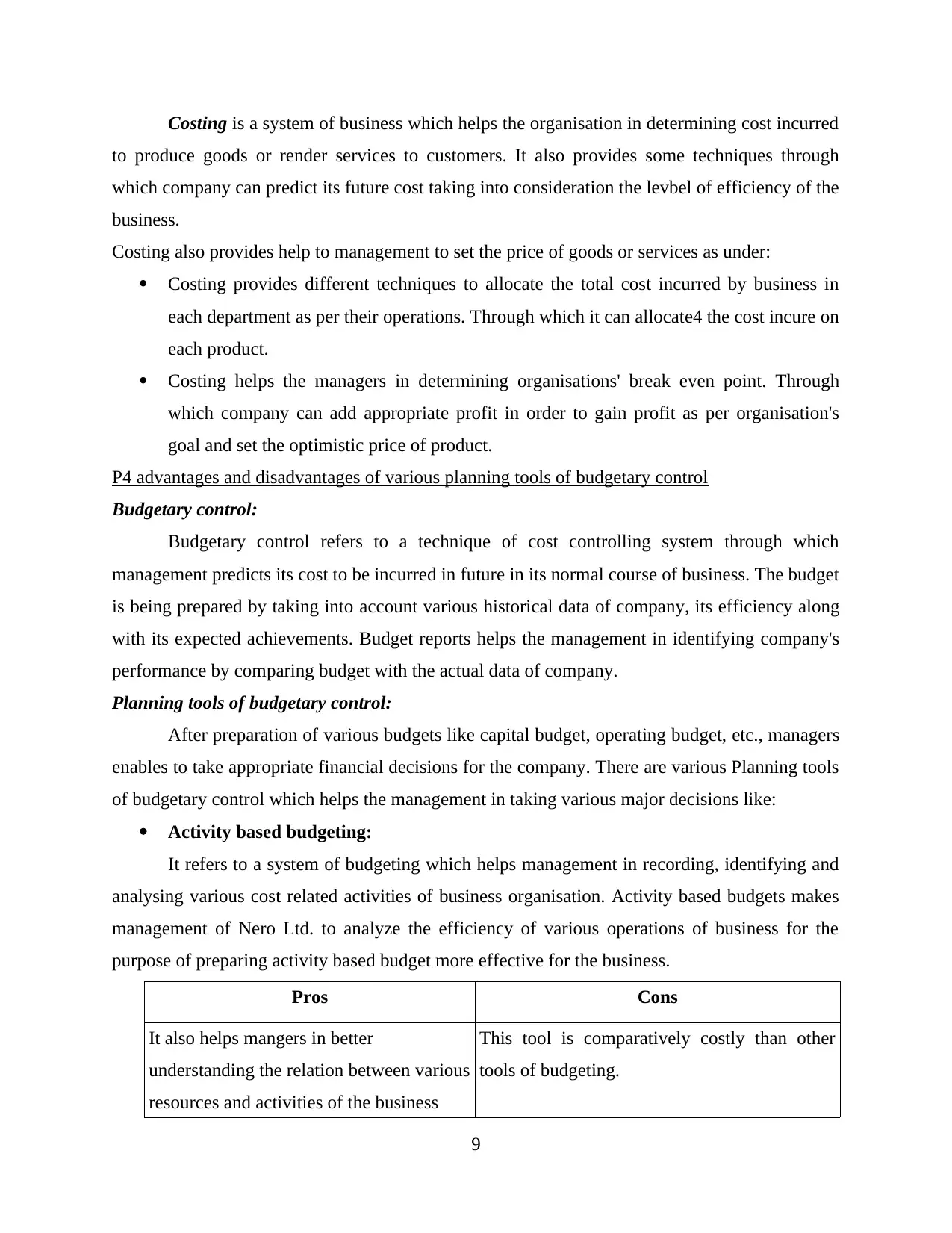
Costing is a system of business which helps the organisation in determining cost incurred
to produce goods or render services to customers. It also provides some techniques through
which company can predict its future cost taking into consideration the levbel of efficiency of the
business.
Costing also provides help to management to set the price of goods or services as under:
Costing provides different techniques to allocate the total cost incurred by business in
each department as per their operations. Through which it can allocate4 the cost incure on
each product.
Costing helps the managers in determining organisations' break even point. Through
which company can add appropriate profit in order to gain profit as per organisation's
goal and set the optimistic price of product.
P4 advantages and disadvantages of various planning tools of budgetary control
Budgetary control:
Budgetary control refers to a technique of cost controlling system through which
management predicts its cost to be incurred in future in its normal course of business. The budget
is being prepared by taking into account various historical data of company, its efficiency along
with its expected achievements. Budget reports helps the management in identifying company's
performance by comparing budget with the actual data of company.
Planning tools of budgetary control:
After preparation of various budgets like capital budget, operating budget, etc., managers
enables to take appropriate financial decisions for the company. There are various Planning tools
of budgetary control which helps the management in taking various major decisions like:
Activity based budgeting:
It refers to a system of budgeting which helps management in recording, identifying and
analysing various cost related activities of business organisation. Activity based budgets makes
management of Nero Ltd. to analyze the efficiency of various operations of business for the
purpose of preparing activity based budget more effective for the business.
Pros Cons
It also helps mangers in better
understanding the relation between various
resources and activities of the business
This tool is comparatively costly than other
tools of budgeting.
9
to produce goods or render services to customers. It also provides some techniques through
which company can predict its future cost taking into consideration the levbel of efficiency of the
business.
Costing also provides help to management to set the price of goods or services as under:
Costing provides different techniques to allocate the total cost incurred by business in
each department as per their operations. Through which it can allocate4 the cost incure on
each product.
Costing helps the managers in determining organisations' break even point. Through
which company can add appropriate profit in order to gain profit as per organisation's
goal and set the optimistic price of product.
P4 advantages and disadvantages of various planning tools of budgetary control
Budgetary control:
Budgetary control refers to a technique of cost controlling system through which
management predicts its cost to be incurred in future in its normal course of business. The budget
is being prepared by taking into account various historical data of company, its efficiency along
with its expected achievements. Budget reports helps the management in identifying company's
performance by comparing budget with the actual data of company.
Planning tools of budgetary control:
After preparation of various budgets like capital budget, operating budget, etc., managers
enables to take appropriate financial decisions for the company. There are various Planning tools
of budgetary control which helps the management in taking various major decisions like:
Activity based budgeting:
It refers to a system of budgeting which helps management in recording, identifying and
analysing various cost related activities of business organisation. Activity based budgets makes
management of Nero Ltd. to analyze the efficiency of various operations of business for the
purpose of preparing activity based budget more effective for the business.
Pros Cons
It also helps mangers in better
understanding the relation between various
resources and activities of the business
This tool is comparatively costly than other
tools of budgeting.
9
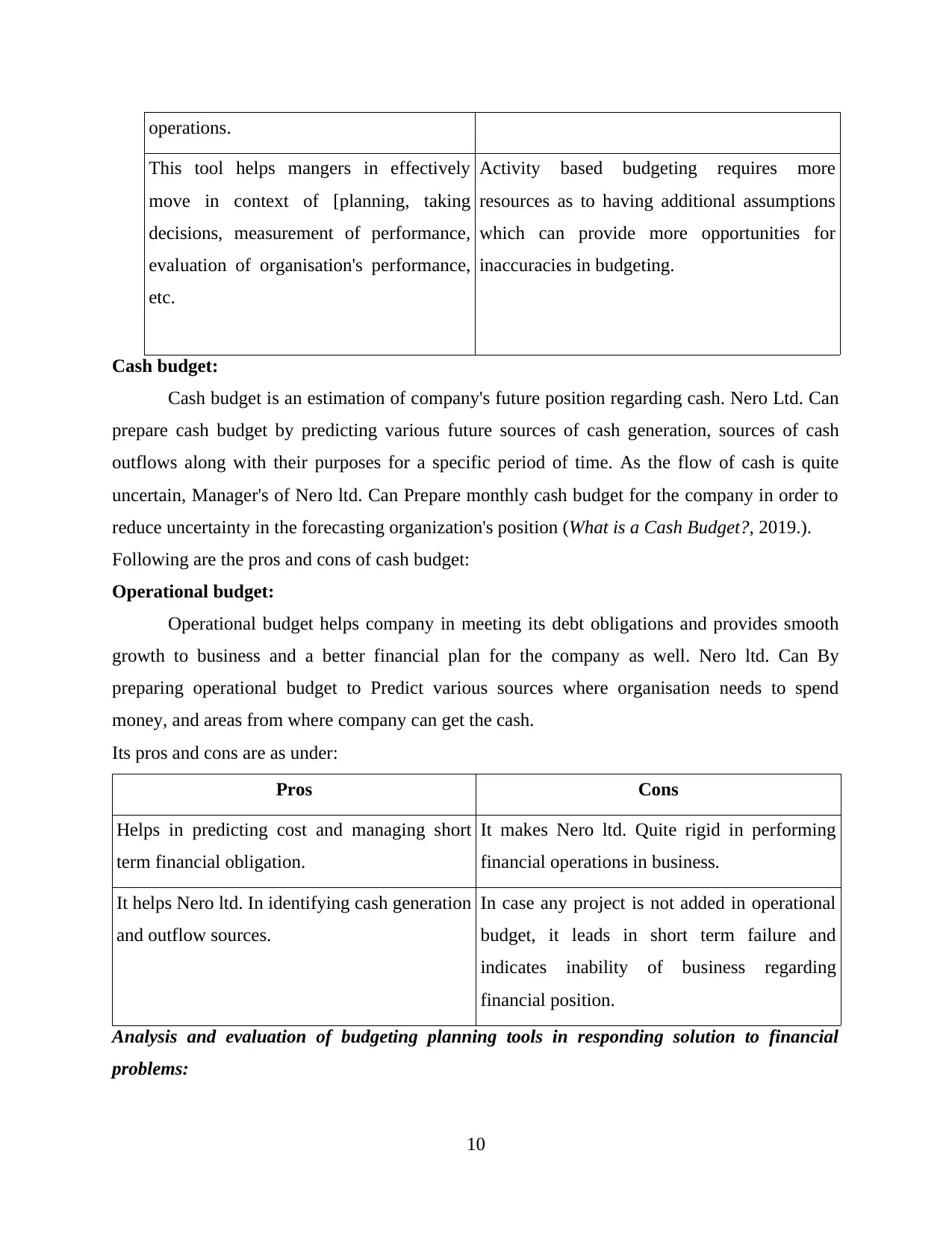
operations.
This tool helps mangers in effectively
move in context of [planning, taking
decisions, measurement of performance,
evaluation of organisation's performance,
etc.
Activity based budgeting requires more
resources as to having additional assumptions
which can provide more opportunities for
inaccuracies in budgeting.
Cash budget:
Cash budget is an estimation of company's future position regarding cash. Nero Ltd. Can
prepare cash budget by predicting various future sources of cash generation, sources of cash
outflows along with their purposes for a specific period of time. As the flow of cash is quite
uncertain, Manager's of Nero ltd. Can Prepare monthly cash budget for the company in order to
reduce uncertainty in the forecasting organization's position (What is a Cash Budget?, 2019.).
Following are the pros and cons of cash budget:
Operational budget:
Operational budget helps company in meeting its debt obligations and provides smooth
growth to business and a better financial plan for the company as well. Nero ltd. Can By
preparing operational budget to Predict various sources where organisation needs to spend
money, and areas from where company can get the cash.
Its pros and cons are as under:
Pros Cons
Helps in predicting cost and managing short
term financial obligation.
It makes Nero ltd. Quite rigid in performing
financial operations in business.
It helps Nero ltd. In identifying cash generation
and outflow sources.
In case any project is not added in operational
budget, it leads in short term failure and
indicates inability of business regarding
financial position.
Analysis and evaluation of budgeting planning tools in responding solution to financial
problems:
10
This tool helps mangers in effectively
move in context of [planning, taking
decisions, measurement of performance,
evaluation of organisation's performance,
etc.
Activity based budgeting requires more
resources as to having additional assumptions
which can provide more opportunities for
inaccuracies in budgeting.
Cash budget:
Cash budget is an estimation of company's future position regarding cash. Nero Ltd. Can
prepare cash budget by predicting various future sources of cash generation, sources of cash
outflows along with their purposes for a specific period of time. As the flow of cash is quite
uncertain, Manager's of Nero ltd. Can Prepare monthly cash budget for the company in order to
reduce uncertainty in the forecasting organization's position (What is a Cash Budget?, 2019.).
Following are the pros and cons of cash budget:
Operational budget:
Operational budget helps company in meeting its debt obligations and provides smooth
growth to business and a better financial plan for the company as well. Nero ltd. Can By
preparing operational budget to Predict various sources where organisation needs to spend
money, and areas from where company can get the cash.
Its pros and cons are as under:
Pros Cons
Helps in predicting cost and managing short
term financial obligation.
It makes Nero ltd. Quite rigid in performing
financial operations in business.
It helps Nero ltd. In identifying cash generation
and outflow sources.
In case any project is not added in operational
budget, it leads in short term failure and
indicates inability of business regarding
financial position.
Analysis and evaluation of budgeting planning tools in responding solution to financial
problems:
10
⊘ This is a preview!⊘
Do you want full access?
Subscribe today to unlock all pages.

Trusted by 1+ million students worldwide
1 out of 15
Related Documents
Your All-in-One AI-Powered Toolkit for Academic Success.
+13062052269
info@desklib.com
Available 24*7 on WhatsApp / Email
![[object Object]](/_next/static/media/star-bottom.7253800d.svg)
Unlock your academic potential
Copyright © 2020–2025 A2Z Services. All Rights Reserved. Developed and managed by ZUCOL.





